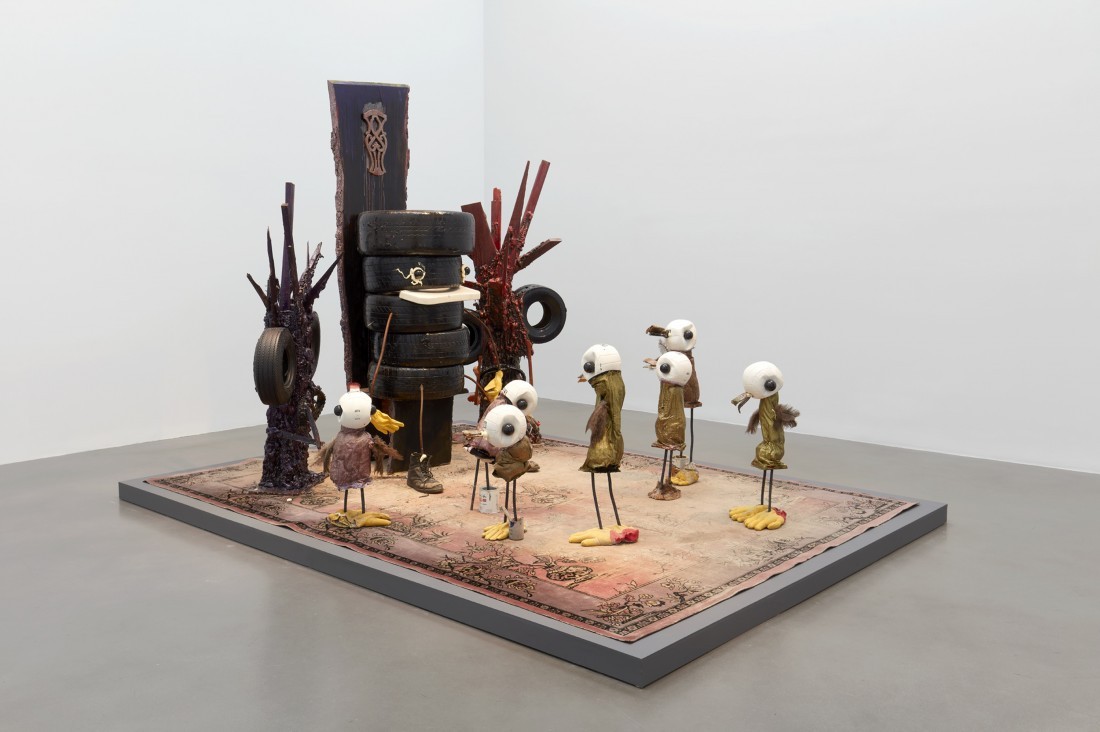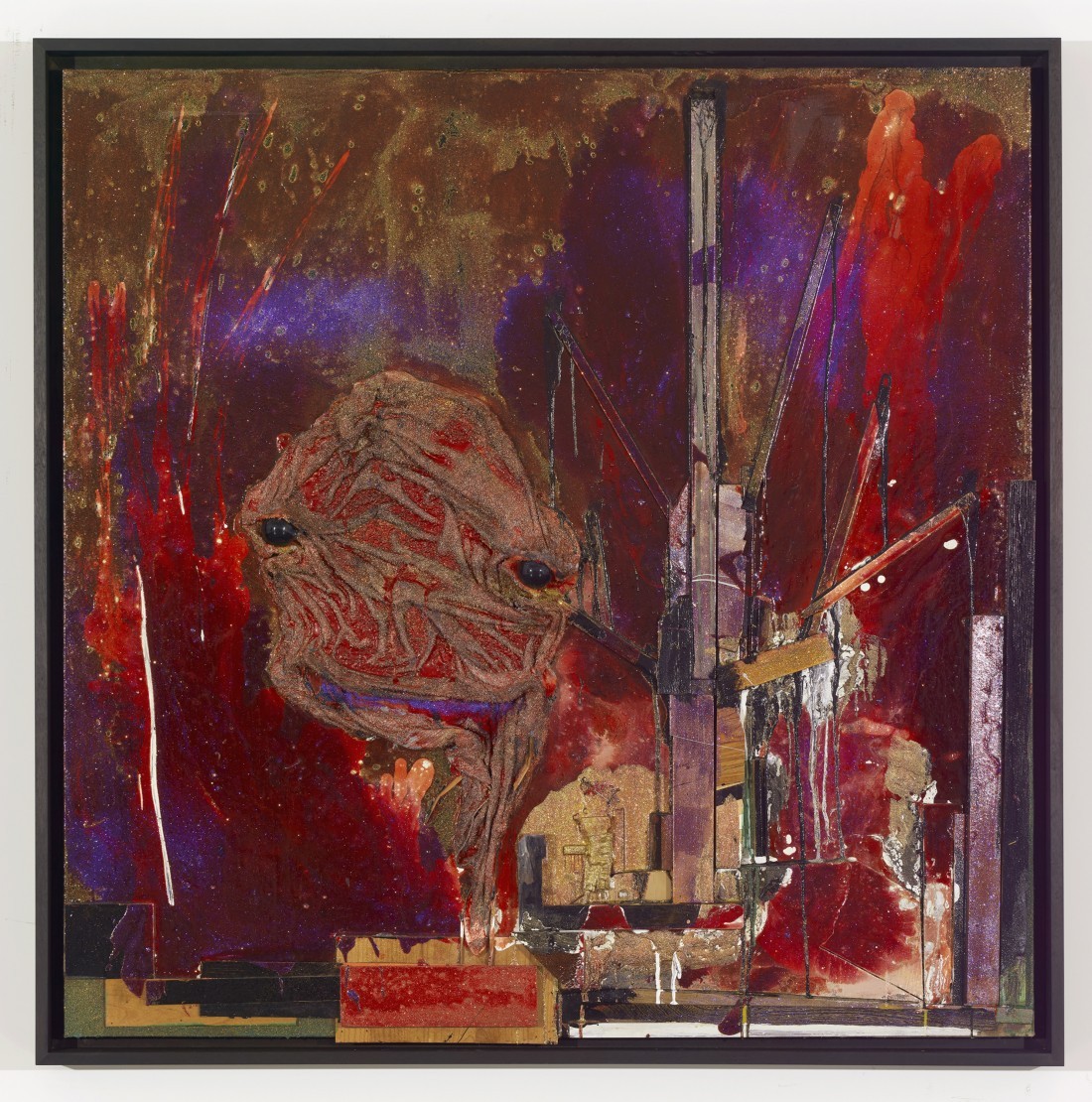Jon Pylypchuk
Jon Pylypchuk’s “Waiting for the Next Nirvana” at the Petzel Gallery in Chelsea, Manhattan, debuted a significant new body of work in painting and sculpture. It was titled after the Generation X article of faith that the last great rock band was Seattle’s Nirvana. “Waiting for another Nirvana” was a normal thing in the 1990s for rock fans to talk about, and to believe in as an emotionally meaningful idea, a kind of pop cultural messianic thinking, an MTV/Much Music teleology. The received wisdom was, and maybe still is, that nothing within that genre of music has since touched the level of raw authenticity, poetry and power of that band, fronted by Kurt Cobain (who killed himself in 1994)—and that the audience for that kind of scene has been waiting around for more than 25 years for something like it, in a state of genuinely hurt bewilderment and disappointment. For Pylypchuk, saying so or admitting as much now, in this context, implies two things: first off, a belated self-awareness, which is ironically nihilistic and contains the core fact that the true moment and message have passed by and can never return. But it also signifies a spiritually tinged, unreconstructed belief in the eventual return of the Real; a fervent, committed sort of asceticism, in which the acolyte will unerringly recognize the Next Big Thing, if and when it appears— and when it comes, it can and will be The Deliverer.

Jon Pylypchuk, Cast your empire on a kingdom of doubts, 2019, wood, wood glue, watercolour ink, rebar, volleyballs, tires, polyurethane, paint brushes, paint cans, gloves, glitter, carpet, black cue balls, 102 x 152 x 111 inches.
If that sounds like a little bit too much, it probably is. Even so, an unfulfillable, profound longing for some fount of cultural meaning and visceral expressiveness isn’t exactly something most of us have to try to imagine wanting and lacking. We don’t all live with a panacea of fulfilling emotional immediacy. Signs and wonders, whether in pop music or contemporary art or otherwise, are hard to come by. So in this show, where a semi-abstract but recognizable landscape filled with absurd cartoonish figures sparkles and shimmers in a resplendent psychedelic cosmos, it seems as though we have no choice but to start off pretty detached and blasé—and to remain open to something strange and special happening.
However strategically sincere or insincere this show actually is, in some regards, it doesn’t try to hide the fact that its true sincerity is mostly hidden. It isn’t because of any specific formal moment that the mojo of this stuff will rock your world, but if you look for a while, it just might. Liking it comes easily enough, but you have to be into this sort of thing to love it—and if you are, then you will. The works, which are as much symbolist as anything else in stylistic terms, rely heavily on a DIY punk aesthetic of kooky, sci-fi and comic-book-tinged, tongue-incheek imagery and materials that recall Halloween and high school parties, head shops and teenage notebooks, garage sales, junkyards and garbage dumps. Glitter is very liberally used, and knick-knacks and resin and fabrics that must have come from second-hand clothing stores, along with a pungently successful colour palette. It is aggressively kitschy work in some respects, affecting a winking and skilful distribution of its references and techniques, rather than allowing many signs of go-for-broke passion, like when there was a particularly good episode of The Simpsons. As is hinted at in Nirvana’s lyric “it’s fun to lose and to pretend,” Pylypchuk made this work with a knowing cool, tinged with a counterbalance of dark, hysterical joy. After spending some time with the work, its quieter and more sincere aspects start to peek out, just like the frightened googly eyes of the awkward denizens in the images themselves, which seem to become more alive and complex in their inner lives.

Jon Pylypchuk, I think about you every day … sexy thoughts, 2019, fabric, wood glue, watercolour, glitter, black cue balls, polyurethane, wood on linen on panel. Framed dimensions: 63.5 x 63.5 x 3.25 inches. Courtesy the artist and Petzel, New York.
There’s another aspect of the show title that is apparently pertinent to Pylypchuk, just as it was to the band Nirvana, which is the popular reading of the Hindu concept of Nirvana as a kind of heaven without the Judeo-Christian God or structure, or Western concept of sin and punishment. Such an afterlife may or may not be preferable to any other vision of our ultimate destiny, but pieces like Thank you fizz, you are our sunshine and Your words are like angels quietly come together as if they may be a vision of just such a place. Or at least a dream of such a vision, a hoped-for end, dovetailing nicely with the more explicitly acknowledged longing for deliverance in the here and now, on the plane of pop culture spirituality and contemporary art communications. Legitimate glimpses of a spiritual infinite are both alluded to and perhaps genuinely attempted, although the artwork folds back its most blatant foray into shamanistic release as in the jangly I used to be your internet kids. We have to remember our feet are on the ground—Nirvana has not actually come, or returned.
The large sculpture Cast your empire on a kingdom of doubts sums up our relationship to the show, staging a confrontation by a group of observing, waiting figures with what seems to be a wacky trinity of celestial beings, or a visitation by a power trio of interesting visitors, or a spectacle of rubber tire muppets from somewhere. Whether we are better represented by the trio or the multitude is an open question. It’s a piece that both embodies and represents a skeptic’s attempt to produce a fervent moment of religious commitment, an act of summoning, that is also an admission of a self-conscious inability to do so. But rather than that being a bad thing, it’s in its winking, distancing safety valve of fun distancing that the meaning of it is produced. Like in Waiting for Godot, or Waiting for Guffman, it’s the waiting in “Waiting for the Next Nirvana” that we’ve been waiting for.
“Waiting for the Next Nirvana” was exhibited at Petzel Gallery, New York, from January 9 to February 29, 2020.
Benjamin Klein is an artist, writer and independent curator living and working in Montreal and Brooklyn.

